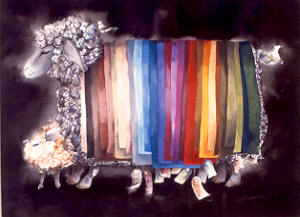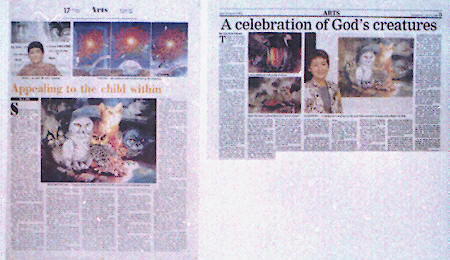
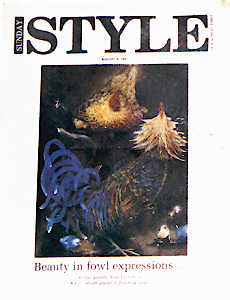
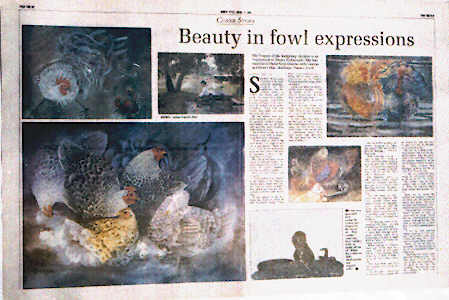
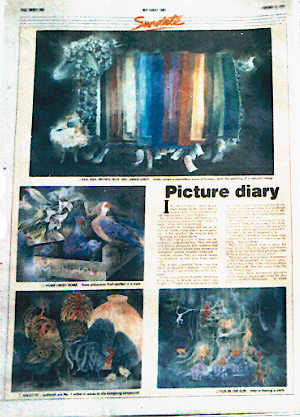
source: extracted from New Straits Times Malaysia/1996/07/04
| A celebration of God's creatures by Ooi Kok Chuen/N.S.T Malaysia/1996/07/04 |
| Beauty in fowl expressions by Tan Gim Ean/N.S.T Malaysia 1991/08/04 |
| Appealing to the child within by J.Anu /Sunday Star Malaysia/1996/04/07 |




source: extracted from
New Straits Times Malaysia/1996/07/04
A Celebration of God's creatures by Ooi Kok Chuen
There are delightful whiffs of fairy-tale romance in artist Shoko Lee's technicolour menagerie of animals and birds.
In this idealised world, a cat feels uncannily at home with a family of owls, a crab is incongruously put vis-avis a slightly ruffled cockerel, the deer and tiger share space without having any proprietorial or predatory instincts.
What comes out is the family spirit and the sense of "live and let live" among animals of different shapes, sizes, types and behavioural patterns. These are the main actors in Shoko Lee's third chapter of her My Diary artistic odyssey, subtitled The Joy of Living (1985-88). There are altogether 39 watercolours, each measuring 52 x 72cm.
Imagine a cast drawn from Edward Lear's The Owl and the Pussycat, Lewis Carroll's Alice Through the Looking Glass, T.S. Eliot's Old Possum Book of Practical Cats which inspired the longest-running Sir Andrew Lloyd Webber musical entitled Cats, and you'll get the picture. It is as if somebody had forgotten to put back the lid on a Pandora's box of a magical animal kingdom, resulting in the release of domesticated and wild animals and their fine-feathered friends.
Her works celebrate all types of living beings, each with its own beauty and having peculiar features for specific functions and with an equal right to life. They also show segments of the avifauna as one big happy family, amidst the bountiful food resources of a Clean Earth environment.
Though Shoko, 48, avoids making caricatures or loads her "characters" with pretentious intellectual baggage, a deeper message can be discerned underneath the "Disneyland" gaiety. Like in the nursery rhymes or fairy-tales, her animals also become anthropomorphic tales of mortality, morality and memory.
The "albino tiger" and rhinoceros (Sumatran?) are bedecked with strips of rainbow-coloured cloth, like price tags on their skins/hides in the illegal trade in endangered species.
The tiger picture is ostensibly a happy one with the cub seen in a playful mood, yet it could also be seen as clinging to the parent in fear of an impending separation. The buzzard quietly sitting on the rump of the rhino adds an ominous element tot the picture, while owls are not exactly harbingers of good tidings either.
Even in the cat-in-the-owl-family picture, the fixed "eyeball-to-eyeball" gaze looks accusing and this little tension is not helped by a half-opened matchbox with two sticks used, but with Shoko's trademark chilli from her first My Diary series of 1981-83.
The odd juxta positioning of chillies with crabs, strollers and toys harks of a period when she was pregnant with her first daughter Hui Ling. The repertoire in the second My Diary series of 1983-85 changes to rubber trees, basket of fruits, vegetables, guinea hen, cats and birds.
Shoko is not unduly concerned, too, about not showing the creatures in their true colours, so you get a mother leopard in green, and the rhino and hippopotamus studded with flower petals.
"I always marvel at the unique shapes and colours of animals and birds. It's incredible," said Shoko, whose first flush of fame was when her self-illustrated storybook, Sunny Boy (Berita Publications), became a book legend in Malaysia in 1980.
The animals are endowed with features for specific functions that either make them distinctive or ensure their survival in terms of protection or food foraging, like the long curving snout of the anteater or the long neck of the giraffe.
Mostly her works are about togetherness, family life and a sense of belonging. The goat suckling the young, a brood of orang utans in a family portrait or in what can be seen as a tourism plug, an orang utan in a trishaw.
While her earlier two My Diary were produced in a realm of mock fantasy especially with the ambiguous floating space on which the subjects are placed, the present series look more earthbound, and yet the whimsical burst of psychedelic so well contrasted and matched makes the subjects look a mite unreal.
Compared to the more scientific basis of Sunny Boy, this body of works is more earth-bound. They are a result of observations in trips with the family to zoological gardens, parks and the neighbourhood itself where the ordinary fowl and feline fascinate her enough to want to put them on canvas.
They are consistent with her development as an artist in Malaysia since she married fellow-artist Lee Kian Seng in 1972, and came over to this land of "brilliant sunshine" and "endless boundary of natural green."
As she wrote about her first impressions: "Dawn. I was pleasantly awakened by cockerels outside my bedroom window on my first morning in Malaysia. Going outside into the cool morning air, I was met with a delightful surprise when a few pretty goats frisked by, followed by placidly strolling cows chewing cud, chickens and cocks capering about, pecking for food... it was a typical kampung (village) morning scene, and a very lively one too."
by Ooi Kok Chuen, New Straits Times Malaysia/1996/07/04

************************************************
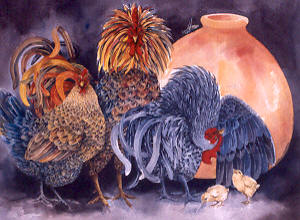 |
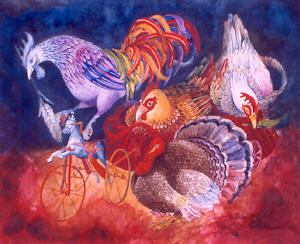 |
Source: extracted from Sunday Star Malaysia/1996/04/07
Appealing to the child within by J.Anu
Shoko
Lee's paintings will always evoke the child in us.
While
they are by no means child-like in their inception nor childish in their
execution, they nevertheless recall happier and simpler emotions through their
lyrical colours and ludicrous actors.
In
My Diary – The Joy of Living (1985-1988), an exhibition of watercolour
paintings, all manner of fowl or pachyderm, rhino or wilder-beast and other
rainbow-clad animal take on personas that the artist has made for herself… and
us.
Owls
wink at the viewer as their stylised feathers preen in lush emeralds and
striking cobalt’s, their piercing eyes playing host to a cross-eyed, seemingly
simple-minded feline friend who sits in their midst.
The
rhinoceros and the tiger are draped in silken rainbows as if to soften their
clichéd temperaments.
And
the cockerels crowing strut is captured and then exaggerated in the most
unlikely colours imaginable. Their forms are stylised through an intricate
interpretation of each and every feather that gives these works their textured
rhythms and hilarious liveliness.
In
the process, she manages to give them all manner of human guises. Often she
includes little man-made objects like the ever-present box of matches or a
vintage Rolls Royce armoured car or a spanking new Lamborghini side by side with
her manic animal friends.
Firstly,
they seem to be used as symbols of the ever-present threat of humanity on
Nature’s kingdoms. Secondly, and perhaps more interestingly, the artist says
that the parallels between nature and all the man-made objects they inspire
caused her to include them at random.
“Take
the car, for example, which has come from the horse carriage – the four wheels
are like the four legs of a horse…” she explains.
Of
course, purely as an aesthetic device, the man-made features of these objects
– the precise and unforgiving nature of the lines of an automobile or the
ordered Chinese characters on the matchbox – provide an exciting contrast to
the flamboyant curves and form of the animals.
All
of which is heightened by her use of an internal light which seems to emanate
from within the theatre of her art.
Shoko
discards the conventional or directional use of light… not merely a practical
plaything for painting, the light in her paintings seems to symbolise the spirit
of the creatures of her art.
Through
the forests of her mind, Shoko gives us some of the most unpretentiously
endearing depictions of a fantasy world where harmony and goodwill prevail.
And
to describe these watercolours as “child-like” implies a frivolity that the
paintings quickly deny. Within the exaggerated vibrancy of her watercolours and
their powerful compositions, Shoko succeeds in transporting the ordinary to the
extraordinary.
Syed
Ahmad Jamal, pioneer artist and academic, describes Shoko as an artist who
“bridges the naïve world of the universal child and the sophisticated world
of the contemporary adult”.
Shoko
herself seems shy to the point of being uncomfortable at all the attention her
art has brought her.
Small
and slight, she exudes a soft-spoken gentility and general good manners that is
undeniably translated into her paintings.
Born
in Japan, Shoko (now a Malaysian) met her husband, artist Lee Kian Seng, in
Japan and came to live in Malaysia in 1972.
According
to the artist, she marvelled at the deep sense of expressive freedom she found
in her husband as well as his native Malaysia.
“For
the first time (in my life) I had the freedom and time to indulge in my own
pleasant thoughts.”
If
art is indeed contemplative and emotive, then everything about Shoko’s new
home touched her eye and heart.
“Malaysia
is the home to my free soul and mind. Though I was born in Japan, I started my
career in Malaysia. All my paintings were created, grown and born here.”
The
kampung life, the crystal clear waters of Tioman, the blazing Malaysian sun and,
most of all, her pregnancy as well as her consequent experience as a mother all
played a crucial part in the development of her aesthetic vocabulary.
The
sun became the centre of her Sunny Boy children’s book, which gave
Malaysians their first taste of Shoko in 1972.
Sadly
out of print, the book showed the artist in precious form as she told her story
of the son of the Sun as he witnesses the grandeur of the earth as well as the
folly of man as far as his environment is concerned.
It
is a theme that underlies many of the concerns that are reflected in her works
till this day.
In
consequent exhibitions, the artist explored the phenomena of her two pregnancies
– her obsessions with hot food through her famous chillies – and later, her
experiences with her children, whether in the everyday antics of a child and
their incessant questions or the magical visits to the zoo, and translated them
into images that all of us can relate to.
This
coming exhibition is the third in the My Diary showings, the fist two in
the 80s, all of which, in the guise of telling children’s stories, most
significantly explore the delicate balance of man’s relationship with Nature
as well as each other.
In
a current artistic temperament that is constantly searching for epic themes and
grandiose finales, it is especially gratifying to find an artist who takes the
simplest of imagery and through the total involvement with it gives us images
that we can like, relate to and always contemplate.
by J.Anu ,Sunday Star Malaysia/1996/04/07
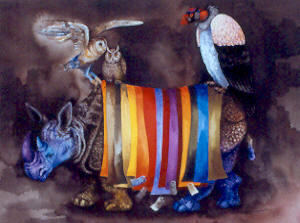
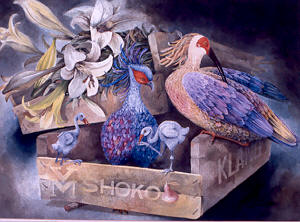
****************************************************
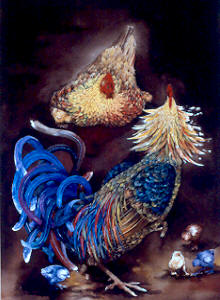
source: extracted from
New Straits Times Malaysia/Sunday
Style/1991/08/04
Beauty in fowl expressions
By Tan Gim Ean
The beauty of the kampung ( village fowl) chicken is an
inspiration to Shoko Lee. She has translated these fowl visions onto canvas in
colours that challenge Nature itself.
Shoko Lee cries fowl in the most colourful
language. Luckily for her neighbours, her vocabulary consists of strokes and
shapes, and not words. The images born of Shoko’s fowl language can be hailed
as lords and ladies of the backyard, all decked out in earthy splendour. They
kick and scratch, they cackle and peck, they strut and roost.
She has painted hens with purple and green down,
cockerels parading rainbow plumes, vain turkeys that are far from cold, and
little chicks huddling under maternal wings.
One is moved to ask: Are the kampung ayam
(village fowl) really
as beautiful as those in her paintings?
“If you want to stick to the same shades, you
might as well take a photograph,” Shoko answers. “I see the hen and paint it
using my own colours and style of expression. I want to challenge Nature’s
beauty.”
But even as she pushes poetic licence to sublime
heights, she acknowledges that no artist can match the “Great Designer” and
His incredible creations.
Why hens and turkeys, you ask again.
“These paintings are inspired by the beauty in
the kampung, which is quiet, simple and original. They are visions of
what I have picked up from my environment, and they make up my diary.”
At this chapter in her life, Shoko has chosen to focus on only the positive things. “I am aware of the hardships and suffering, but for now, I want to concentrate on its beauty. Painting beautiful things makes me happy.”
Colour was what first attracted this artist to
poultry. “I like the feathers of the cockerel, with its myriad hues. If I had
land, I would keep them.”
As an alternative, she breeds them on canvas.
Most mornings, Shoko will bump into her feathered
friends while taking her two daughters for a jog round their housing estate in
Klang (Malaysia).
Shoko’s six new fowl paintings are part of a
kampung (village) series which she started working on in the early ‘80s. In 1983 and
1985, she opened up chapters of her life for scrutiny at the My Diary 1981-83
and My Diary 1983-85 exhibitions.
Her Malaysia debut, in 1983, featured works
centred round her pregnancy and her first year of motherhood with Hui Ling, now
nine. She painted chillies, strollers, crabs and toys.
The solo sequel in 1985, when she was expecting
Hui lian, unveiled rubber trees, baskets of fruits and vegetables, cats, a
guinea hen and her brood, and birds. Last year, Shoko printed an animal series
of greeting cards featuring a sheep, a cockerel, pheasants and monkeys.
“The kampung ayam (village fowl) is a continuation of my diary… my view of what I see, feel and think.”
As a
full-time artist, she tries to paint daily although sometimes, nothing comes of
it. Composing a picture is tough work as “what I feel today may change
tomorrow.”
Before starting to compose, she’ll lock herself
away in a room. “I must be very quiet. But when I am colouring, I have music
on, any kind of music. I never get tired when colouring.”
How does Shoko react when her kampung ayam
end up on a platter?
“It’s all right. I always feel Nature must
have a balance. We eat chicken for food, but they lay eggs everyday. So life
goes on, in a natural cycle.”
